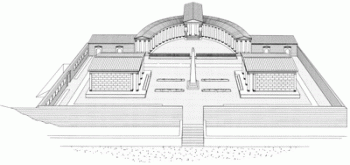American Journal of Archaeology | The Journal of the Archaeological Institute of America
You are here
The Antinoeion of Hadrian’s Villa: Interpretation and Architectural Reconstruction
January 2007 (111.1)
The Antinoeion of Hadrian’s Villa: Interpretation and Architectural Reconstruction
Recent excavations at Hadrian’s Villa have revealed the remains of a structure with a large exedra, numerous architectural elements, and some sculptural fragments in the Egyptian style. The characteristics of some of the finds immediately brought to mind Hadrian's connections with Egypt, the long-standing “Egyptian problem” in studies of the villa (e.g., the Canopus-Serapeum), and naturally, Antinous. In this article, we examine specific aspects of the structure and identify it as the Antinoeion, based, in part, on a masonry foundation that may be connected to the famous obelisk of Antinous at Rome. We also present, for the first time, an architectural reconstruction of the building. We argue that the Antinoeion is not simply a mausoleum or cenotaph and temple where the cult of the dead youth Antinous, who was assimilated to Osiris, could be associated with that of other Egyptian divinities. Rather, it is a true tomb housing the remains of Antinous. It is here suggested that this tomb was built so that Hadrian could commemorate his paramour to whom he was joined by a deeply passionate and spiritual bond.
The Antinoeion of Hadrian’s Villa: Interpretation and Architectural Reconstruction
By Zaccaria Mari and Sergio Sgalambro
American Journal of Archaeology Vol. 111, No. 1 (January 2007), pp. 83–104
DOI: 10.3764/aja.111.1.83
© 2007 Archaeological Institute of America


